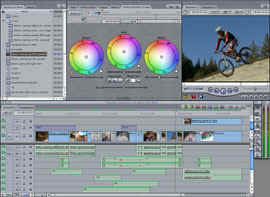 Film Editing Software generally follow one of two metaphors: the user-friendly video workshop or the all-inclusive movie factory. Programs in the first category, like iMovie, appeal to newcomers because they’re limited in functionality and avoid complexity at every turn. These straight forward tools usually feature drag-and–drop icons and present large buttons as a way to select a desired effect. They hide their power behind a façade of simplicity. Designed to remove any intimidation from the filmmaking process, most such interfaces succeed in making editing a fun and stress-free experience.
Film Editing Software generally follow one of two metaphors: the user-friendly video workshop or the all-inclusive movie factory. Programs in the first category, like iMovie, appeal to newcomers because they’re limited in functionality and avoid complexity at every turn. These straight forward tools usually feature drag-and–drop icons and present large buttons as a way to select a desired effect. They hide their power behind a façade of simplicity. Designed to remove any intimidation from the filmmaking process, most such interfaces succeed in making editing a fun and stress-free experience.Other video editing applications, like Adobe Premiere and Apple Final Cut Pro, hail from a long line of professional non-linear editing systems and a legacy of broadcast techniques. Their development has been years in coming, and along the way their feature sets have been both streamlined and enhanced to give editors greater control and flexibility—at the cost of complexity. These environments are not immediately intuitive (in fact, novices may find them a bit daunting); however, they do allow users to fine-tune almost every aspect of digital production. You can alter the colors of clips, the behavior of text, and almost every variable of your special effects and transitions. However, in the process the interface often becomes convoluted with cascading windows, tiny buttons and sliders, and submenus that can easily overwhelm the casual user. Making matters even more confusing, several of these popular programs have recently added compositing modules and special effects controls—both previously the exclusive domain of separate applications.


This movement toward all-in-one editors has created some two-headed monsters: programs that can do it all but demand tremendous processing power and substantial computer memory. Many of these applications also depend on the use of third-party plug-ins to extend their capabilities, which has made managing software and hardware configurations a complicated prospect.
Final Cut Pro, for example, is a professional package with an extensive set of special effect filters and titling controls, but it doesn’t run efficiently on any Macintosh model with less than 450 Mhz speed and at least 256 Mb of RAM. Nevertheless, the software quickly made inroads in the broadcasting world because it followed many of the conventions of established editing programs and incorporated titling and composting functions previously found only in separate, stand-alone applications.

Avid’s Xpress is another example of a high-end film editing application. This software was once the industry darling, dominating most high-end post-production facilities. Until recently, the software was only available bundled with a souped-up system, completed by some proprietary enhancements. However, today’s computers can finally meet the demands of this award-winning digital video editing interface, and the Xpress DV software is now sold independently of its hardware.
Both the simple and the complex film editing program can give the everyday computer user enough functionality to create short films of full features. Pick one, and you’ll likely never need another: That’s because those drawn to simplified interfaces tend to stay away from programs with more extensive capabilities. And those who choose more sophisticated applications invest so much time in training they’re unlikely to jump to a competing product.
2 comments:
Actually, your entry on Avid Xpress Pro is incorrect. Avid Media Composer is the industry standard long used by television and film professionals. Avid announced a software-only version of Media Composer this year. Until then, Avid Xpress Pro was the lower-end option for software-only configurations.
well if you read clearly, there's a line which says "This software was once the industry darling, dominating most high-end post-production facilities."
Post a Comment